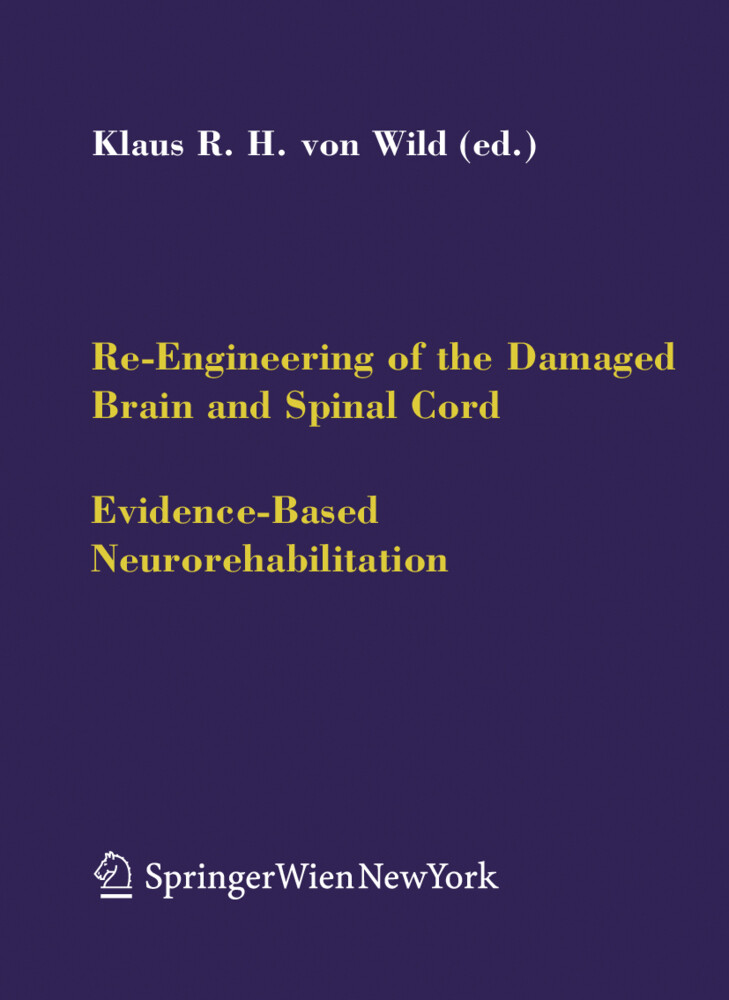
Zustellung: Di, 08.07. - Do, 10.07.
Versand in 4 Tagen
VersandkostenfreiBestellen & in Filiale abholen:
Re-EngineeringoftheDamagedBrainandSpinalCord isdedicatedtoTetsuoKanno, M. D. ProfessorofNeurosurgery Bypresenting theoriginal papers thatmakeupthis thefeaturesofthelocalmedicallandscapeinthe- third supplement we wish to make a further contri- gionswheretheyareenacted. Whatismore, progr- bution to the issue of functional rehabilitation, this sivenew? ndingsmustbealsosubjectedtoafrequent soimportantandfascinatingmodernareaofresearch revision. Ontopofthis, itshouldnotbeforgottenthat inthe? eldofneurosciences. Thecongresspaperswe even when committal therapy guidelines are c- haveselectedconstituteagoodre? ectionofthetrans- sistentlyapplied, thereareconsiderablevariationsin disciplinary objectives. The literature references are therangeofpotentialcomplicationsandintheo- designedasaguidetoleadtheinterestedreadertoa comeofprospectivecontrolledmulti-centreandmul- deeperandmoredetailedunderstandingoftheindi- nationalstudiesontheissueofqualitymanagement. vidualissues. Functionalrehabilitationhasbeenanoriginaltask The demand for evidence-based medicine is well ofneurosurgeryfromtheveryoutset. The1990shave justi? ed; however, it rapidly comes up against the enteredtheannalsofbrainresearchasthe Decadeof limitsoffeasibility, especiallywherecontrolledthe- theBrain . Sincethentherehasbeenaneverstronger peuticstudiesareconcerned. TheCochrancollection growthofneuroscienti? cinterestworldwide, accom- of high-quality evidence-based healthcare databases paniedbysubstantial? nancialengagement. Thishas hasthusfarbeenofnohelptousindrawingupthe- primarily resulted in advances in basic neuro- peutic recommendations for the re-engineering of biologicalandneurophysiologicalresearchandalsoin brain and spinal-cord lesions. Today as ever, the thegrowthofneuroscienti? cknowledgeaboutbasic opinion of experts and empirically based medical mechanismsformotor control, paincontrol, aware- treatment and posttraumatic neurorehabilitation ness, cognition, learning and memory. The conse- continuetooccupyanindispensablepositionforthe quencemustbetoensurethattheadvancesmadeinthe everydayclinicalpracticeofneurosurgicalandneu- neuroscienti? cresearchareaareadequatelyexpanded traumatological therapies. Promising adjunct - intopracticalneurosurgicalcareandre-engineeringof proachesincludeneuropharmacology, forcascadesof brainandspinalcordlesionsandtoensureuponnew molecular interactions are known to be underlying approaches. Following this a fundamental path will activity-dependent plasticity and skills learning, as resultinanimprovedandmoree cientpreventionin many of these processes involve the major tra- thefuture, themeasuresthatstandrightatthefore- mitters. Furthermore, biologicalinterventionsby- front of all rehabilitation principles, meaning that ingendogenousneuronsandgliaaswellasexogenous conventionalconceptsmustbemodi? edtokeeppace stemcells, bone-marrowcells, macrophages, andother withthemoretask-speci? c, intensive, andprogressive types may promote the regeneration of nerve cells, demands. In this connection a series of guidelines, tissue, and neural circuitry. Class one studies have recommendations, and expert opinions and also beenmade, andnowclasstwostudieshavebeeni- algorithms have been elaborated by national and tiated, for example in connection with acute spinal international expert panels and multidisciplinary as- cord injury (SCI). The clinical application of fu- sociationsfortheacutemedicalcareofpatients.
Inhaltsverzeichnis
Evidence based neurorehabilitation. - Evidence based medicine in neurological rehabilitation a critical review. - Quality management in traumatic brain injury (TBI) Lessons from the prospective study in 6. 800 patients after acute TBI in respect of neurorehabilitation. - Posttraumatic epilepsy with special emphasis on prophylaxis and prevention. - Swallowing therapy a prospective study on patients with neurogenic dysphagia due to unilateral paresis of the vagal nerve, Avellis syndrome, Wallenberg s syndrome, posterior fossa tumours and cerebellar hemorrhage. - Impaired self-awareness after moderately severe to severe traumatic brain injury. - Assessment of health-related quality of life in persons after traumatic brain injury development of the Qolibri, a specific measure. - Re-engineering of brain lesions. - RNA editing: a molecular mechanism for the fine modulation of neuronal transmission. - Inhibition of I? B? phosphorylation prevents glutamate-induced NF-? B activation and neuronal cell death. - Reorganization of cerebral circuits in human brain lesion. - Transcranial magnetic stimulation in neurorehabilitation. - Is there impairment of a specific frontal lobe circuit in head injury? . - Treating the aging brain: cortical reorganization and behavior. - The localization of central pattern generators for swallowing in humans a clinical-anatomical study on patients with unilateral paresis of the vagal nerve, Avellis syndrome, Wallenberg s syndrome, posterior fossa tumours and cerebellar hemorrhage. - Functional regeneration of the axotomized auditory nerve with combined neurotrophic and anti-inhibitory strategies. - Electrically evoked hearing perception by functional neurostimulation of the central auditory system. - Physiological recordings from electrodesimplanted in the basal ganglia for deep brain stimulation in Parkinson s disease. The relevance of fast subthalamic rhythms. - DBS therapy for the vegetative state and minimally conscious state. - Deep brain stimulation for idiopathic or secondary movement disorders. - Extradural Motor Cortex Stimulation (EMCS) for Parkinson s disease. History and first results by the study group of the Italian neurosurgical society. - Endocrine dysfunction following traumatic brain injury: mechanisms, pathophysiology and clinical correlations. - Taylored implants for alloplastic cranioplasty clinical and surgical considerations. - Lessons from National and International TBI Societies and Funds like NBIRTT. - Re-engineering of spinal cord lesions. - Brachial plexus surgery (Honorary lecture). - Results in brachial plexus palsy after biceps neuro-muscular neurotization associated with neuro-neural neurotization and teno-muscular transfer. - Macrophages and dendritic cells treatment of spinal cord injury: from the bench to the clinic. - Electrophysiological effects of 4-aminopyridine on fictive locomotor activity of the rat spinal cord in vitro. - Alternative, complementary, energy-based medicine for spinal cord injury. - The effect of penile vibratory stimulation on male fertility potential, spasticity and neurogenic detrusor overactivity in spinal cord lesioned individuals. - Posttraumatic syringomyelia a serious complication in tetra- and paraplegic patients. - Functional neurorehabilitation in locked-in syndrome following C0 C1 decompression. - Treatment options and results in cervical myelopathy. - The treatment of the sacral pressure sores in patients with spinal lesions. - Neurological-neurosurgical-neurobehavioral rehabilitation. - Phenomenological aspects of consciousness itsdisturbance in acute and chronic stages. - Neuropsychological experiences in neurotraumatology. - Team care in ICU Psychotherapeutic aspects and taking care of family of patients with traumatic brain injury. - Early clinical predictive factors during coma recovery. - Predicting one year clinical outcome in traumatic brain injury (TBI) at the beginning of rehabilitation. - Severe brain injuries in children. - The locked-in syndrome: a challenge for therapy. - Addendum. - WFNS committee for neurorehabilitation. - Academia Multidisciplinaria Neurotraumatologica AMN. - NBIRTT, the National Brain Injury Research, Treatment and Training Foundation.
Produktdetails
Erscheinungsdatum
19. Oktober 2010
Sprache
englisch
Auflage
Softcover reprint of hardcover 1st ed. 2005
Seitenanzahl
240
Reihe
Acta Neurochirurgica Supplement
Autor/Autorin
G. A. Brunelli
Herausgegeben von
Klaus R.H. Wild
Verlag/Hersteller
Produktart
kartoniert
Abbildungen
XVI, 240 p.
Gewicht
645 g
ISBN
9783211998779
Entdecken Sie mehr
Bewertungen
0 Bewertungen
Es wurden noch keine Bewertungen abgegeben. Schreiben Sie die erste Bewertung zu "Re-Engineering of the Damaged Brain and Spinal Cord" und helfen Sie damit anderen bei der Kaufentscheidung.









